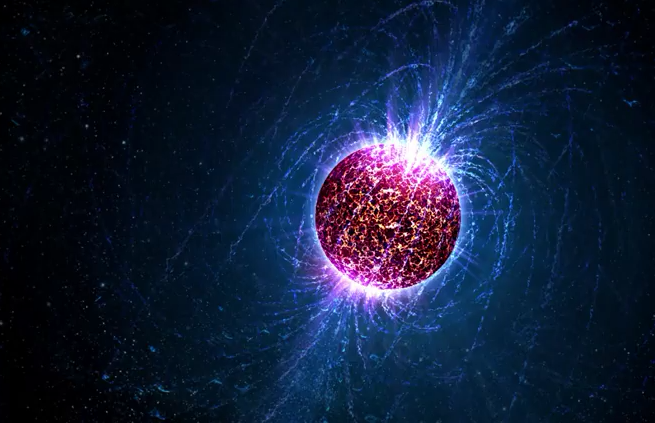In 2007, an astronomer named Duncan Lorimer discovered an oddly brief, strong radio signal
2007年,一位名叫罗瑞莫·邓肯的天文学家发现了一段奇怪而简短的强烈无线电信号。
that seemed to come from an unidentified source in space. Astronomers were baffled.
它似乎源于太空中的一个不明来源。天文学家们都困惑不已。
Usually, bursts of radio waves come in predictable, repeating patterns,
通常情况下,一波波无线电波都以可预测、重复的模式传送进来,
like the ones we've detected from stars called pulsars. This was totally new.
就像我们已经从脉冲星上探测到的那样。但这完全是新的。
At first, skepticism was high that this lone burst was important.
开始时,这段单独的电波很重要,人们对此持很高的怀疑态度。
Sometimes weird signals turn out to just be glitches,
因为有时,一些奇怪的信号被证明是小故障,
or we find out that they're caused by interference from communications equipment on Earth.
或者我们发现它们是由地球上通讯设备的干扰引起的。
But with more research, astronomers confirmed that the signal wasn't just a glitch,
但随着进一步研究,天文学家们确定这信号不是小故障,
and it came from at least 3 billion light-year away.
它来自距离地球至少30亿光年的地方。
The question was: what caused it?
那么问题是:它是由什么引起的?
Ten years later, we still have no idea.
十年间,我们毫无头绪。
Since Lorimer's initial discovery, we've found more of these signals.
自罗瑞莫的最初发现后,我们发现了更多这种信号。
They're known as fast radio bursts, or FRBs, which is actually a pretty descriptive name:
它们被称为快速无线电暴(FRBs),这个名字描述得非常恰当。
they're quick bursts of bright light in the radio wavelength range of the electromagnetic spectrum.
它们是在电磁波谱的波长范围内快速闪过的明亮无线电波,
FRBs last just a few milliseconds, and so far,
快速无线电暴仅持续几毫秒,到目前为止,
we've only been able to detect them from Earth by pointing telescopes in exactly the right direction at precisely the right time.
从地球上,我们只能通过定向望远镜在精确的时间和方向上探测到它们。
But since we don't know where they come from, we don't really know where to look or when to expect them.
但由于我们不知道它从哪儿来,所以我们也不知道该看哪儿、什么时候能看到,
Which is part of why we've detected less than two dozen FRBs so far.
这就是我们目前探测到的快速无线电暴还不到24个的部分原因。
In the past decade, astronomers have come up with a few ideas about what might be causing them.
在过去十年,天文学家们对它产生的原因做了几种猜测。
One option is that the FRBs come from collapsing neutron stars,
一种观点认为快速无线电暴源于瓦解的中子星,
the rapidly spinning, ridiculously dense cores left over after certain stars go supernova.
在某些星星形成超新星后,快速旋转的高密度内核被遗留下来。
If the neutron star is dense enough, it'll be overcome by gravity and collapse into a black hole.
如果中子星密度够大,它就会摆脱地心引力,然后瓦解成一个黑洞。
But if it's spinning fast enough, that can hold off the collapse for a little bit.
但如果它旋转得够快,它就能稍微推迟瓦解的时间。
When the neutron star eventually faces its doom, its magnetic field will be ripped apart,
当中子星最终毁灭时,它的磁场将会崩溃,
which could cause charged particles within the star to shoot out a quick, bright burst of radio waves, in other words, an FRB.
这会导致其内部的带电粒子放射出一波又快又亮的无线电波,换句话说,就是一个快速无线电暴。
Another possibility is that FRBs come from two very dense objects merging, like black holes or neutron stars.
另一种可能性是快速无线电暴源自两个非常密集对象的合并,如黑洞或中子星。
As they spiral in toward each other, the merger causes tons of energy to be thrown out of the system,
当它们相互旋转时,这种合并造成大量的能量被排出系统,
possibly in the form of a fast radio burst.
排出形式可能就是快速无线电暴。

Researchers have come up with lots of potential explanations like these,
研究人员想出来许多诸如此类的猜测,
but they haven't been able to confirm any of them yet.
但他们还不能做任何的验证。
The other issue is that these explanations only fit single, isolated FRBs.
另一个问题是这些解释仅适用于单独的快速无线电暴。
But in 2016, astronomers announced that they'd discovered 10 repeating bursts that all seemed to come from the same source.
但在2016年,天文学家宣布,他们发现了10段来自同一源头的重复电波。
One possibility is that repeating bursts come from a magnetar,
一种可能是这种重复的电波来自于一个磁星,
a special type of neutron star that's super magnetic and spins especially fast.
磁星是一种特殊类型的中子星,它有非常强的磁性,而且旋转得特别快。
These stars might produce FRBs when they send out flares.
这些磁星发出耀斑时可能会产生快速无线电暴。
But even though these explanations might make sense in theory,
但即使这些解释理论上来说有道理,
they're all just educated guesses based on the types of things
但研究人员只是根据事物的类型做得猜测,
researchers think could possibly send out brief, strong bursts of radio waves.
他们认为这些事物可能会发出短暂而强烈的无线电波。
This whole field of research is still really new, and astronomers don't have much data to work with.
现在整个研究领域仍是全新的,天文学家们没有太多的数据可研究。
But they're hoping to have a lot more soon.
但他们希望不久后会有很多数据。
Based on how the number of bursts we've found
基于我们发现的电暴次数,
compares to how long we've spent looking for them in different parts of the sky,
与我们在天空不同部分寻找它们所花时间的比较,
researchers think an FRB might reach Earth as often as every 10 seconds.
研究人员认为快速无线电暴可能每隔10秒就能抵达地球,
And they're trying to catch as many of them as possible.
他们试图尽可能多地捕获它们。
Most of the telescopes astronomers use are designed to be really sensitive,
天文学家使用的大部分望远镜都设计得非常灵敏,
because they're trying to detect the faintest signals.
因为他们试图探测到微弱的信号。
These telescopes can only focus on tiny areas of the sky at a time,
这些望远镜一次只能聚焦一小块儿天空,
so they're not good at detecting unpredictable things like FRBs.
所以它们不擅长探测如快速无线电暴之类的不可预知的东西。
But FRBs are so strong that you don't need a super sensitive telescope to spot them.
快速无线电暴如此之强,你不需要一个超灵敏的望远镜来发现它们。
Astronomers are planning to take advantage of that.
天文学家正计划利用这一点优势。
One of the most promising projects, set to start at the end of 2017,
一个最有前途的项目将于2017年底开始,
will use the Canadian Hydrogen Intensity Mapping Experiment, or CHIME.
它将采用加拿大氢强度测绘实验即CHIME。
CHIME is made up of four, hundred-meter-long open cylinders with multiple antennas,
加拿大氢强度测绘实验是由四个百米长、带有多重天线的开放圆筒组成,
which will allow it to monitor much larger patches of the sky than other higher-sensitivity telescopes
这将使它监测到的天空范围
that can only monitor one small area at a time.
比其他高灵敏度望远镜一次聚焦的小区域更大。
Using CHIME, astronomers think they'll be able to detect more than a dozen FRBs per day.
利用CHIME,天文学家们认为他们每天能够发现超过12个快速无线电暴。
Other projects are using telescopes that are even less sensitive,
其他项目是利用灵敏度更小的望远镜,
like one that will use an array of ten 5-meter-wide dishes to search huge patches of the sky.
其中一个将使用10个口径5米宽的望远镜列阵来搜索巨大的天空。
So, hopefully soon we'll be detecting way more FRBs,
所以,希望我们很快就能检测到更多的快速无线电暴吧!
which should help astronomers figure out which of their ideas are right.
这应该能帮助天文学家找出他们的哪些想法是正确的,
Or maybe they'll find out that all their ideas were wrong.
或许他们会发现所有的想法都是错误的。
Either way, we still have a lot to learn about what's out there.
不管怎样,我们还有很多东西要学习。
Thanks for watching this episode of SciShow Space,
感谢收看这期的太空科学秀。
and thanks especially to our patrons on Patreon who help make this show possible.
特别感谢“Patreon”上的赞助人对本节目的大力支持。
If you want to help us keep making episodes like this,
如果你想帮我们继续制作这样的节目,
you can go to patreon.com/scishow to learn more.
你可以去patreon.com/scishow了解更多信息
And don't forget to go to youtube.com/scishowspace and subscribe!
也别忘了去youtube.com/scishowspace订阅哦!












